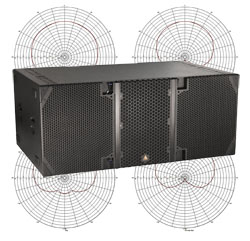
The E219 is designed to function as a “normal” subwoofer, while a system comprised of E219s will provide true cardioid output by physically reversing one or more of the enclosures to face rearward in respect to the forward facing enclosures (Figure 3, below) and selecting the appropriate DSP settings, which include a unique all forward-facing “End Fire” preset that enhances multi-band rear cancellation without smearing impulse response.
Long a proponent of cardioid subwoofer deployment, the Adamson design team developed Convertible Cardioid Technology that was initially seen in the SpekTrix subwoofer in 2003. The experience gained from that project led to the development of a series of advanced DSP algorithms for Energia subwoofers.
Standard presets include regular non-directional usage plus three commonly used directional configurations: two enclosures arranged front-back (FB), three enclosures arranged front-back-front (FBF), and enclosures (quantity dependent upon on how many are stacked) configured in an end-fired array (EF66) (Figure 4, below).
All three configurations offer improved directional control in comparison to “standard” sub arrays, with the EF66 offering the greatest directionality by using advanced filters that achieve wide-band cancellation with only two sources – while maintaining impulse response integrity.
In a standard end-fired configuration, the null frequencies are determined by spacing and amount of sources, but Adamson’s proprietary algorithms are intended to provide wider rejection with only two sources, thus allowing the user to achieve maximum rearward rejection from a minimal footprint. All cardioid presets are stand-alone, with no extra delay or phase reversal required to take advantage of the benefits of cardioid low-frequency propagation.
The Full Package
As with all Energia enclosures, the E219 is constructed of marine grade birch plywood, measuring 23.5 x 55.8 x 35 inches (h x w x d) and weighing 249 pounds.
Boxes can be ground-stacked or flown using modular rigging frames made of a combination of aircraft grade aluminum and high-carbon steel. The integrated rigging permits a 0 or 3-degree box-to-box angle. The reason to splay subwoofers at 3 degrees in most application scenarios is to not block HF coverage of the lower boxes in a steeply curved main hang when flown side by side.
When landing an E219 array of enclosures set to 3-degree splay angles, the cabinets will automatically collapse to 0 degrees.
No physical manipulation needs to be done. Transport carts that hold up to three E219s are supplied as standard with each turn-key system.
Lab.gruppen PLM 2000Q amplifiers supplied with Energia systems offer 4 channels in a 2RU package, supplying 5,000 watts per channel at 2.2 to 3.3 ohms, and 4,400 watts per channel at 4 ohms. A Universal Regulated Switch Mode power supply (100 to 240 volts) allows the amplifiers to operate properly anywhere in the world, while PFC (power factor correction) significantly reduces AC current draw on the mains, as well as parasitic noise on the power grid.
The onboard Lake processing provides crossovers, EQ, delay and protective limiter settings. It can be controlled via the front panel, a Lake Controller on a tablet, or addressed, controlled, and vital signs monitored via Ethernet or WiFi.


